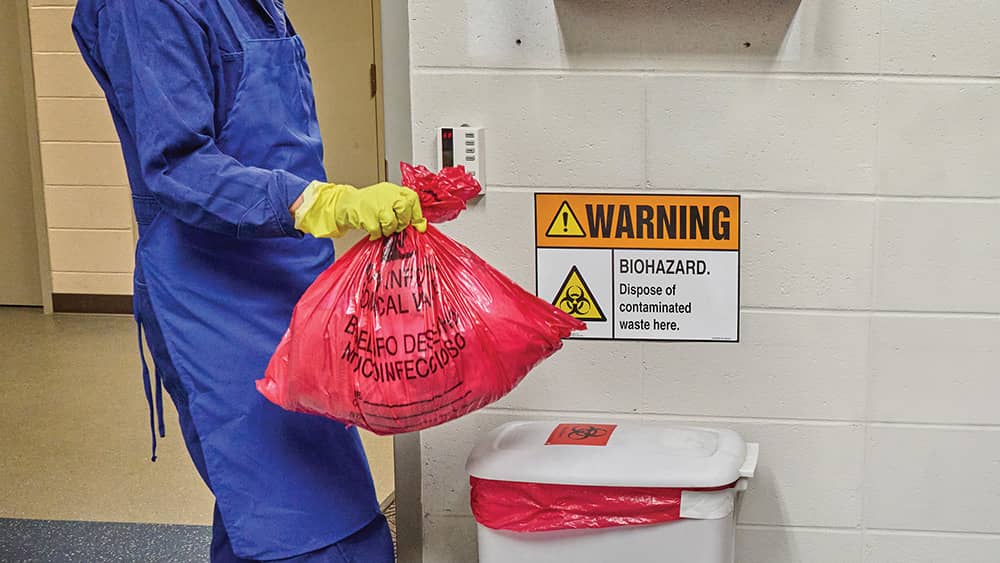Bloodborne Pathogens Training
Helps employers satisfy the BBP training requirements of 29 CFR 1910.1030
This training curriculum includes vital information on the risks that bloodborne pathogens pose, methods employees can take to limit exposure, and what to do if they've had an exposure incident with blood.

Exposure to bloodborne pathogens can happen in the workplace. Bloodborne pathogens are microorganisms that live in a person's blood. They can cause serious diseases like hepatitis B, hepatitis C, HIV, AIDS, malaria, and Ebola. Employees with "occupational exposure" are likely to have contact with blood and certain other body fluids at work. Those with occupational exposure need to know what to do if they have an incident with blood or certain other body fluids.
Bloodborne Pathogens Training Curriculum
The Bloodborne Pathogens Training curriculum is designed to help learners understand how to protect themselves and lessen the risks of exposure.
IMPORTANT: This curriculum is designed to help employers satisfy the training requirements of 29 CFR 1910.1030. It includes vital information on the risks that bloodborne pathogens pose, methods employees can take to limit exposure, and what to do if they've had an exposure incident with blood.
Three modules are included within the Bloodborne Pathogens Training curriculum.
Bloodborne Pathogens Training: Risks and Requirements
This bloodborne pathogens training is designed to help learners understand the risks involved with occupational exposure and the requirements in place to keep them safe.
Bloodborne Pathogens Training: Preventive and Control Measures
This bloodborne pathogens training is designed to help learners understand the preventive and control measures related to bloodborne pathogens.
Bloodborne Pathogens Training: Markings, Exposure Incidents, and Records
This bloodborne pathogens training is designed to help learners recognize biohazard markings and guide them through an exposure incident.
-
Help your employees protect themselves and lessen the risks of exposure
- START TRAINING FOR FREE

These training programs are also available to download for use on your own Learning Management System (LMS) or company intranet!
Bloodborne Pathogens Training FAQS
Bloodborne pathogens are microorganisms present in human blood that can cause disease in exposed humans. They include things like hepatitis B virus, hepatitis C virus, HIV, and almost a dozen other viruses, bacteria, or pathogens.
Any general industry or shipyard employer (of any size) that has one or more employees with occupational exposure falls under 29 CFR 1910.1030. “Occupational exposure” is reasonably anticipated contact with blood or other potentially infectious materials (OPIM) that may result from the performance of an employee’s duties. The standard is not meant solely for healthcare settings. For example, if an employee in a manufacturing facility is designated or expected to perform first aid involving blood-related injuries or to clean up blood spills, then that employee is covered.
Yes, this training is required for any general industry or shipyard employees who have occupational exposure. The standard does not specify a training duration, but it does list the required elements to cover during training and requires a qualified trainer.
Employees must get initial and annual refresher training, but annual refreshers do not need to be as comprehensive as the initial training. In addition, if tasks or procedures change during the year in a way that affects their exposure, covered employees must be trained in those changes.
The answer depends on the type of record. Training records must be kept for at least three years. If an employee suffers an exposure incident as defined by the standard, a record of the incident must be kept for at least five years. Finally, certain employee medical records must be kept for at least the duration of employment plus 30 years.
A sharp is any object that can penetrate the skin. Most people think of needles, but broken glass and box cutter blades are also sharps. When these items are not contaminated with blood or OPIM, the employer can throw these items in the trash. However, when blood or OPIM is present or reasonably anticipated to be present on needles, glass shards, or blades, they’re considered to be contaminated sharps and must be handled with caution. When an employer falls under 1910.1030, contaminated sharps need to be immediately disposed of properly in a sharps container (not in the regular trash).
No, the standard applies only to employees with occupational exposure, meaning reasonably anticipated contact with blood or OPIM as part of their job duties. If an employee voluntarily assists an injured coworker and is not otherwise designated or expected to perform that assistance, that good Samaritan act is not covered by the OSHA standard.
These jobs are not automatically covered. No matter the job, the employer must determine which job classifications or specific tasks and procedures involve occupational exposure. Tasks such as cleaning toilets, emptying trash that may have soiled bandages or napkins, and cleaning up vomit do not normally involve occupational exposure. The employer should still evaluate and make a determination, however. If blood or OPIM is discovered during routine duties, the janitor, custodian, or housekeeper should contact the employee who is designated and trained to handle it.
Why J. J. Keller® Training?
ROBUST ONLINE TRAINING LIBRARY
Access the industry’s largest online training library, consisting of 950+ unique E-Learning courses, 500+ customizable training resources, and more.
STREAMING VIDEO FOR ADDED IMPACT
Make the most of your classroom training sessions with 300+ hi-res training videos developed by adult learning specialists.
EASY ACCESS ANYTIME, ANYWHERE
Enjoy maximum flexibility in and out of the classroom with 24/7 access to hundreds of titles and our free mobile app for training on the go.
EXPERT CONTENT YOU CAN TRUST
Backed by 70 years of industry experience, our courses center on actionable learning objectives and receive regular updates from our in-house experts to reflect the latest regulatory changes.
FREE RECORDKEEPING AND REPORTING
Easily track which employees have been trained on which topics and when, and identify any lapses in your training program – at no added cost.
INVALUABLE MANAGEMENT RESOURCES
As an administrator, you’ll gain exclusive access to the J. J. Keller® Training Knowledge Center, where you can reference word-for-word regulations, ask our experts specific compliance questions, and more.


